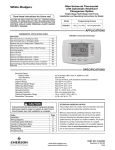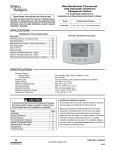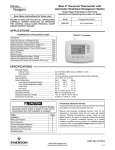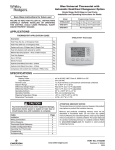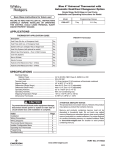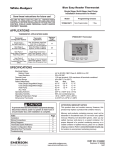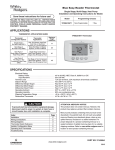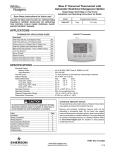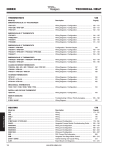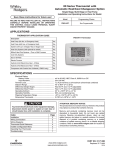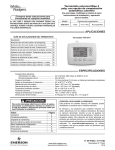Download White Rodgers 1F95-0680 Thermostat User Manual
Transcript
Blue Commercial Thermostat with
Automatic Heat/Cool Changeover
Option and Damper Control
Single Stage, Multi-Stage, Heat Pump
Installation and Operating Instructions for Model:
Save these instructions for future use!
FAILURE TO READ AND FOLLOW ALL INSTRUCTIONS
CAREFULLY BEFORE INSTALLING OR OPERATING THIS
CONTROL COULD CAUSE PERSONAL INJURY AND/OR
PROPERTY DAMAGE.
Model
Programming Choices
1F95-0680
7 Day
5/1/1 Day
Non-Programmable
APPLICATIONS
THERMOSTAT APPLICATION GUIDE
1F95-0680 Commercial Thermostat
Description
Heat Pump (No Aux. or Emergency Heat)
Heat Pump (with Aux. or Emergency Heat)
Yes
Yes
Systems with up to 4 Stages Heat, 2 Stages Cool
Yes
Heat Only Systems
Yes
Millivolt Heat Only Systems – Floor or Wall Furnaces
Yes
Cool Only Systems
Gas or Oil Heat
Yes
Yes
Electric Furnace
Yes
Hydronic (Hot Water) Zone Heat – 2 Wires
Yes
Hydronic (Hot Water) Zone Heat – 3 Wires
Yes
Wired Remote Temperature Sensor (Indoor or Outdoor)
Yes
Dual Fuel Damper Control Feature (Heat Pump Mode
Outdoor Remote Required)
Yes
SPECIFICATIONS
Electrical Rating:
Battery Power . . . . . . . . . . . . . . . . . . . . . . . . . .
Input-Hardwire . . . . . . . . . . . . . . . . . . . . . . . . .
Terminal Load . . . . . . . . . . . . . . . . . . . . . . . . . . . . .
Setpoint Range . . . . . . . . . . . . . . . . . . . . . . . . . . . .
Differential (Single Stage) . . . . . . . . . . . . . . . . . . . .
Differential (Multi-Stage) . . . . . . . . . . . . . . . . . . . . .
Differential (Heat Pump) . . . . . . . . . . . . . . . . . . . . .
Operating Ambient. . . . . . . . . . . . . . . . . . . . . . . . . .
Operating Humidity . . . . . . . . . . . . . . . . . . . . . . . . .
Shipping Temperature Range . . . . . . . . . . . . . . . . .
Dimensions Thermostat. . . . . . . . . . . . . . . . . . . . . .
! CAUTION
To prevent electrical shock and/or equipment damage,
disconnect electric power to system at main fuse or
circuit breaker box until installation is complete.
Index
Installation
Wiring Connections
Wiring Diagrams
Thermostat Quick Reference
Installer Configuration Menu
Operating Your Thermostat
Programming
Troubleshooting
Page
2
2
3
4
5
8
9
13
mV to 30 VAC, NEC Class II, 50/60 Hz or DC
20 to 30 VAC
1.5A per terminal, 2.5A maximum all terminals combined
45 to 99°F (7 to 32°C)
Heat 0.6°F; Cool 1.2°F
Heat 0.6°F; Cool 1.2°F
Heat 1.2°F; Cool 1.5°F
32°F to +105°F (0 to +41°C)
90% non-condensing max.
-40 to +150°F (-40 to +65°C)
4.2"H x 6.4"W x 1.7"D
ATTENTION: MERCURY NOTICE
This product does not contain mercury. However, this product may replace a product that contains mercury.
Mercury and products containing mercury must not be
discarded in household trash. Do not touch any spilled
mercury. Wearing non-absorbent gloves, clean up any
spilled mercury and place in a sealed container. For proper
disposal of a product containing mercury or a sealed
container of spilled mercury, place it in a suitable shipping
container. Refer to www.white-rodgers.com for location to
send product containing mercury.
www.white-rodgers.com
PART NO. 37-6819A
0811
INSTALLATION
!
WARNING
Thermostat installation and all components of the
control system shall conform to Class II circuits per
the NEC code.
Remove Old Thermostat
Before removing wires from old thermostat, mark wires for
terminal identification so the proper connections will be made
to the new thermostat.
Installing New Thermostat
1. Pull the thermostat body off the thermostat base. Forcing
or prying on the thermostat will cause damage to the unit.
2. Place base over hole in wall and mark mounting hole
locations on wall using base as a template.
3. Move base out of the way. Drill mounting holes. If you
are using existing mounting holes and the holes drilled
are too large and do not allow you to tighten base snugly, use plastic screw anchors to secure the base.
4. Fasten base snugly to wall using mounting holes shown
in Figure 1 and two mounting screws. Leveling is for
appearance only and will not affect thermostat operation.
5. Connect wires to terminal block on base using appropriate
wiring schematic.
6. Push excess wire into wall and plug hole with a fire resistant material (such as fiberglass insulation) to prevent
drafts from affecting thermostat operation.
7. Carefully line the thermostat up with the base and snap
into place.
Battery Location
2 "AA" alkaline batteries are included in the thermostat at the
factory with a battery tag to prevent power drainage. Remove
the battery tag to engage the batteries.
To replace batteries, set system to OFF, remove thermostat
from wall and install the batteries in the rear along the top of
the thermostat (see Figure 1). For best results, use a premium brand "AA" alkaline battery such as Duracell® or Energizer®. If the home is going to be unoccupied for an extended
period (over 3 months) and
is displayed, the batteries
should be replaced before leaving.
Power Stealing Switch
This thermostat is designed for 24 VAC power to be hardwired via a common connection to the C terminal with battery
back-up. The thermostat also has the capability to be battery
powered with the battery power supplemented by Power
Stealing to extend the battery life. Powered only by the two
"AA" batteries the expected battery life is about one year.
With battery power supplemented by the Power Stealing
circuits the battery life can be extended up to five years. The
supplemental power is derived from the Heating (W) and/or
Cooling (Y) circuits. The thermostat will utilize either one or
both of these circuits to supplement the battery power. The
thermostat "steals" power from these circuits when the circuit
is not active (calling for heating or cooling).
The Power Stealing switches are defaulted to the ON position.
If the thermostat is hardwired with "C" common connection,
both switches should be moved to the OFF position. If the
thermostat is battery powered and the heating or cooling system does not cycle, indicating the system is not compatible,
the switch for the circuit, heating or cooling, experiencing the
incompatibility should be moved to the OFF position.
Figure 1 – Thermostat Base Multi-Stage 1F95-0680
Mounting
Hole
Mounting
Hole
Place Level
across Mounting Tabs
(for appearance only)
Place Level
across Mounting Tabs
(for appearance only)
Rear view of thermostat
2 "AA" Batteries
Power Stealing
Switches
WIRING CONNECTIONS
Refer to equipment manufacturers' instructions for specific
system wiring information. After wiring, see CONFIGURATION section for proper thermostat configuration.
Terminal Designation
Wiring diagrams shown are for typical systems and describe
the thermostat terminal functions.
TERMINAL DESIGNATION DESCRIPTIONS
Description
O/B ........................................... Changeover valve for heat pump energized constantly in cooling and off/heating
Y2 ............................................ 2nd Stage Compressor
Y............................................ Compressor Relay
G............................................ Fan Relay
RC ............................................ Power for Cooling
RH ............................................ Power for Heating
C ............................................ Common wire from secondary side of cooling (Optional). Required for fault indication, continuous backlight operation or remote temperature sensor operation 6 Powered closed 3rd wire for 3-wire zone valve
W/E ........................................... Heat Relay/Emergency Heat Relay (Stage 1) (3rd Stage Heat in HP2)
W2............................................ 2nd Stage Heat (4th Stage Heat in HP2)
- ............................................ Common (DC) for wired remote temperature sensor
S ............................................ Frequency signal from remote temperature sensor
+ ............................................ Power (DC) to remote temperature sensor
A1 ............................................ Output energized in occupied (Morn, Day, and Eve periods)
L ............................................ Compressor diagnostic indicator for systems with diagnostic connection typically found on Heat pump
systems or with Copeland's Comfort Alert
2
WIRING DIAGRAMS
Heat Pump Connections
Figure 1 – Heat Pump Systems
If you do not have a heat pump system, refer
to figures 2 & 3.
Jumper
L
Y
O/B
Y2
W2
W/E
RH
G
C
RC
A1
Refer to equipment manufacturers' instructions
for specific system wiring information.
System
O
Heat Pump 1
(HP1)
Energized in
Cool Mode
Diagnostic
Indicator
or System
Malfunction
Switch
Heat Pump 2
(HP2)
B
Energized in
Heat, Off,
Emergency
Mode
No
Heat and
Output
Cool Mode
1st Stage
(Compressor) 2nd
Stage
(Compressor)
Heat Mode
Heat Mode
3rd Stage.
2nd Stage
Emergency
Mode 2nd
Emergency Stage
Mode
Heat
Mode
1st Stage
4th Stage.
Heat mode Emergency
3rd Stage Mode 2nd
Stage
Blower/
Circulator
Fan Energized 24 Volt 24 Volt Optional*
on Call for
24 Volt
(Hot)
(Hot)
Heat or Cool. Heat
(ComCool
Set Elect/Gas
mon)
Option for
Emergency
Mode
Comfort Alert II Module
or Similar System
Diagnostic Module
You can configure the thermostat for use with
the following heat pump systems.
HEAT PUMP TYPE 1 (HP 1). Single stage
compressor system; gas or electric backup.
NEUTRAL
120VAC
24VAC
See Module Instructions
for details
HOT
CLASS II
TRANSFORMER
* Common connection required for diagnostic or malfunction indication.
After wiring, see INSTALLER CONFIGURATION section for proper thermostat configuration.
Single Stage and Multi-Stage Connections
Figure 2 – Single Stage or Multi-Stage System (No Heat Pump)
with Single Transformer
Refer to equipment manufacturers' instructions
for specific system wiring information.
Jumper
L
Y
O/B
Y2
W/E
G
W2
RH
RC
C
A1
This thermostat is designed to operate a
single-transformer or two-transformer system.
System
Single
Stage 1
(SS1)
MultiStage 2
(MS2)
O
Diagnostic Energized Constantly
Indicator
in
Input
Cool Mode
Cool Mode
or
1st Stage
System
B
Malfunction Energized Constantly
Switch
in Heat, Off,
Input
Emergency
Mode
No Output
No
Heat
Output Mode
1st Stage
Cool
Heat Mode
Mode
2nd Stage
2nd
Stage
Blower/
Circulator
Fan Energized
on Call for
Cool (and
Heat if
configured
for Electric
Heat)
HEAT PUMP TYPE 2 (HP 2). Multi-stage
compressor or two compressor system with
gas or electric backup.
You can configure the thermostat for use with
the following fossil fuel systems:
24 Volt 24 Volt Optional*
24 Volt
(Hot)
(Hot)
(ComHeat
Cool
mon)
SINGLE STAGE (SS 1) gas, oil or electric.
MULTI-STAGE (MS 2) gas, oil or electric.
Comfort Alert II Module
or Similar System
Diagnostic Module
NEUTRAL
120VAC
24VAC
HOT
See Module Instructions
for details
After wiring, see INSTALLER CONFIGURATION section for proper thermostat configuration.
CLASS II
TRANSFORMER
* Common connection required for diagnostic or malfunction indication.
Figure 3 – Single Stage or Multi-Stage System (No Heat Pump)
with Two Transformers
Remove Jumper Wire
between RH & RC
Jumper
L
Y
O/B
Y2
W/E
W2
G
RH
RC
C
System
Single
Stage 1
(SS1)
O
B
Energized Energized
Diagnostic Constantly Constantly
Cool Mode
Indicator
in Heat, Off,
in
(Optional) Cool Mode Emergency 1st Stage
Mode
MultiStage 2
(MS2)
No Output
No
Heat
Output Mode
1st Stage
Heat Mode
Cool
2nd Stage
Mode
2nd
Stage
Blower/
Circulator
Fan Energized 24 Volt 24 Volt Optional
on Call for
24 Volt
(Hot) (Hot)
Cool (and
(ComHeat Cool
Heat if
mon)
configured
for Electric
Heat)
NOTE: If continuous backlight or hardwired power input are desired but do not
function in both HEAT and COOL modes,
cut the heating transformer 24V wires
and tape off. Connect the neutral circuit
disconnected from the heating transformer to the neutral circuit of the cooling
transformer. Disconnect the wire to the
RH terminal and install a jumper between
RH and RC. Depending on the system
requirements, replace the cooling transformer with a 75VA class II transformer if
needed.
NEUTRAL
120VAC
120VAC
24VAC
NEUTRAL
HOT
24VAC
COOLING
HOT
CLASS II
TRANSFORMER
HEATING
CLASS II
TRANSFORMER
Figure 4 – 3-Wire (SPDT) Heat Only Zone Valve Wiring
Jumper
6
Y
W
G
Opens
Valve
(4)
Blower/Circulator
Fan Energized
RH
RC
C
System
Single Stage
3-wire
Zone Valve
application
Constant
Closes
Valve
(6)
24 Volt 24 Volt
(Hot)
(Hot)
Cool
Heat
(5)
24 Volt
(Common)
NEUTRAL
120VAC
24VAC
HOT
CLASS II
TRANSFORMER
3
THERMOSTAT QUICK REFERENCE
Home Screen Description
Figure 5 – Home Screen Display
Room
Temperature
Setting
Temperature
Displays the power level of
the 2 “AA” batteries:
indicates good power level
indicates batteries at about
half power. “Change
” indicates
batteries are low and should be
replaced with 2 new premium brand
“AA” Alkaline batteries.
(See page 2 for more details)
System
Indicator
Fan
Indicator
Figure 6 – Programming & Configuration Items
8
2
4
12
3
1
10
9
11
5
13
Programming and Configuration Items
1
"System On" indicates when heating or cooling stage
is energized. "System On +2" indicates when a second
stage is energized.
2
The word HOLD is displayed when the thermostat is
in the HOLD mode. Temp is displayed when
the thermostat is in a Temporary HOLD mode.
3
Displays Change Filter when the system has run for
the programmed filter time period as a reminder to
change or clean your filter.
4
Displays "Set" for setpoint when in Run Program mode.
5
Displays System Mode (Heat, Em, Auto, Cool, Off)
or Time in menu mode.
6
Displays Fan Mode (On, Auto) Prog FAN On or "Run
Sched" in Menu mode.
4
7
6
7
Displays "Run Schedule", "Schedule", or "Menu".
8
Displays "Save" when Cool SavingsTM is working.
9
Displays "Heat Pump" when system is configured
as Heat Pump thermostat.
10
Displays "Hold" in programmable mode when not in
"Hold" mode. Displays Light Bulb in non-programmable mode.
11
Initially displays "Auto Sched". If Auto Schedule had
been used or disabled, then it displays "Cool Savings"
when in the Cool Mode. Displays "Copy" in Schedule
mode and "Fan" in Fan Schedule mode.
12
"Call For Service" indicates a diagnostic fault in the
heating/cooling system, it does not indicate a fault in the
thermostat.
13
"Keypad Lockout" in Menu mode when selecting keypad Lockout or in RUN when a keypad Lockout is active.
INSTALLER/CONFIGURATION MENU
Press and hold the Menu button for at least 5 seconds. The display will show item #1 in the table below. Press Menu to advance to the next menu item. Press
or
to change a menu item options.
INSTALLER/CONFIGURATION MENU
MENU HP SS PRESS
REF.
BUTTON
DISPLAYED
(FACTORY DEFAULT)
Press
or
to
select from listed options
COMMENTS
1
1
1
MENU
(MS 2)
HP 1, HP 2, SS 1
2
2
2
MENU
(GAS) for SS or MS
ELE
3
3
3
MENU
CS (3)
0, 1, 2, 4, 5, 6
Selects Cool Savings
Value 1 (low) to 6 (high),
Value 0 disables feature
4
4
4
MENU
E (On)
OFF
Selects Energy Management Recovery (EMR)
On or OFF.
5
–
5
MENU
CR Heat (ME)
SL, FA
Adjustable Anticipation:
Selects heating cycle rate for MS or SS in #1 only
6
5
–
MENU
CR Heat Pump
(ME)
SL, FA
Adjustable Compressor Anticipation
(Heat Pump) [only when heat pump (Heat/Cool)
selected in #1]
7
6
6
MENU
CR Cool (ME)
or
CR Au (FA)
SL, FA
Adjustable Anticipation:
Selects the cycle rate for cooling (only when
MS 2 or SS 1 is selected in item 1.) or
Selects the cycle rate for Emergency mode
and Auxiliary stage if Heat Pump is selected
in item 1.
SL
Selects Multi-Stage (MS 2 No Heat Pump),
Heat Pump 1 (HP 1, 1 compressor),
Heat Pump 2 (HP 2, 2 compressor or 2
speed compressor), or Single Stage (SS 1)
GAS setting: furnace controls the blower
ELE setting: thermostat controls the blower
8
7
7
MENU
CL (OFF)
CL On
Compressor Lockout Time
9
8
8
MENU
Cool Off, Em Heat
Auto
Heat Auto Cool Off,
Heat Off with Fan icon,
Heat Off without Fan icon
Cool Off, Auto Off
System Mode Configuration
with Automatic Changeover capability
10
9
9
MENU
dL (On)
dL OFF
Selects Display Light On or OFF
11
10
10
MENU
0
(current temperature)
1 HI, 2 HI, 3HI, 4 HI,
1 LO, 2 LO, 3 LO, 4 LO
Adjustable Ambient Temperature Display
12
11
11
MENU
°F
°C
Selects Fahrenheit/Celsius Temperature Display
13
12
12
MENU
(On) b
OFF
May select Beeper OFF to stop audible
key feedback
14
13
13
MENU
P (7)
3, 0
Defaults 7-day programming (P7) but nonprogrammable (0) or 5/1/1 programming (P3)
is available on most models.
15
14
14
MENU
PS (2)
4
Selects Program periods per day:
4 = Morn, Day, Eve, Night
2 = Day, Night
16
15
15
MENU
Heat AS (On)
OFF
Automatic Schedule for heat mode
17
16
16
MENU
Cool AS (On)
OFF
Automatic Schedule for cool mode
18
17
–
MENU
Heat FA (On)
OFF
Fast Heat option may be disabled by
selecting OFF. NA to SS or HP1 config.
19
18
–
MENU
Cool FA (On)
OFF
Fast Cool option may be disabled by
selecting OFF. NA to SS or HP1 config.
20
19
17
MENU
Remote (OFF)
On
Selects Remote Sensor On/OFF
MENU
Remote
(In)
Outdoor
Selects Remote Sensor to outdoor
NA is Remote Sensor OFF
MENU
Indoor Loc
(On)
OFF
Selects Local Sensor (in thermostat) to OFF.
N/A if Remote is selected to Outdoor
5
INSTALLER/CONFIGURATION MENU
21
20
18
MENU
dS (On)
Off
Selects Automatic Daylight Saving Time option
22
21
19
MENU
(OFF)
Keypad Lockout
L, P, Limit
Selects one of 3 Keypad Lockout configurations
L - Total Keypad Lockout
P - Partial Keypad Lockout
(Up and Keys still work)
Limit - Limited Temperature RANGE
MENU
(000)
Keypad Lockout
1-999
Selects personal lockout code. 000 is NOT A
VALID CODE.
23
22
20
MENU
L Heat
(99)
L 62 to L 98
Select's Limited HEAT Range
24
23
21
MENU
L Cool
(45)
L 46 to L 82
Select's Limited COOL Range
25
24
–
MENU
CO
(05)
6-50
Selects outdoor Compressor OFF temperature
(Balance Point temperature). 05 disables feature. Outdoor Remote required
MENU
(dF)
EA
Selects between dF (dual Fuel) or EA (Electric
Aux) only available is CO > 6
MENU
cd
(60)
Selects Compressor delay OFF time in seconds
Selects AO (Auxiliary OFF) temperature. Feature disabled is 80 selected. Outdoor Remote
required
26
25
–
MENU
AO
(80)
27
26
22
MENU
(OFF) EC
On
Selects Economizer On/OFF
28
27
23
MENU
(O) pp
1-3
Selects no. of hours of preoccupancy purge time
(hours the Fan runs (C an A1 energized)
prior to occupied period)
29
28
24
MENU
Change Filter (OFF)
On
Selects Filter Change-out Indicator On or OFF.
MENU
Change Filter (200 h)
25-1975 h
MENU
(OFF)
Change UV Lamp
On
Selects UV Lamp
Timer: On/OFF
MENU
(350)
Change UV Lamp
25-1975
Selects no. of Days between changing UV Lamp
Heat On (b)
Selects operation of the reversing valve terminal
(O/B) output as an O or B terminal
30
29
25
31
30
26
MENU
Cool On (o)
32
31
27
MENU
RUN SCHED
1) This control can be configured for:
MS 2 – Multi-Stage System (no heat pump)
HP 1 – Heat Pump with one stage of compressor
HP 2 – Heat Pump with two stage compressor or two
compressor system, Gas or Electric backup
SS 1 – Single Stage System
2) GAS or Electric (ELE) fan operation. If the heating system
requires the thermostat to energize the fan, select ELE.
Select GAS if the heating system energizes the fan on a
call for heat.
3) Select Cool Savings™ value – Selects the amount of
adjustment for the Cool Savings™ feature in Cool mode
with 1 (1°) being the least amount of adjustment and 6
(6°) being the most amount of adjustment. Default value
is 3. Cool Savings is an optional energy saving feature that
can reduce your cooling costs. It is based on the principal
that lower indoor humidity makes a slightly higher temperature feel more comfortable. Cool Savings operates
during periods of high demand which normally occur on
the hottest summer days when a cooling system may run
for hours to reach the thermostat setting. Long cooling
run times also lower the indoor humidity. Cool Savings,
6
Change Filter time in 25 hour increments. This
menu only appears if On is selected in above.
Returns to Normal Operation
very slowly, adjusts the setpoint temperature to make the
setpoint closer to the displayed room temperature, to a
maximum of the number of degrees you select. Adjusting the setpoint temperature over a long cooling run time
allows the system to reach your set temperature and turn
off. The room temperature will actually be higher than the
thermostat displays but the reduction in humidity will allow
comfort at the slightly higher temperature.
To turn this feature on in the Cool mode press Cool
Savings. The display will show “Save” next to the setpoint temperature. When Cool Savings is making adjustments to the room temperature display “Save” will be
flashing and the displayed room temperature may vary
within the adjustment range you selected.
If "Save" is not displayed and this feature is OFF, no
change will occur when the cooling system is continuously
running during periods of high demand.
4) Energy Management Recovery: (this step is skipped if
configured to be non-programmable).
Energy Management Recovery (E) On enables the thermostat to start heating or cooling early to make the building
temperature reach the program setpoint at the time you
INSTALLER/CONFIGURATION MENU
specify. Heating will start 5 minutes early for every 1° of
temperature required to reach setpoint.
Example: E On is selected and your heating is programmed to 65° at night and 70° at 7 AM. If the building
temperature is 65°, the difference between 65° and 70° is
5°. Allowing 5 minutes per degree, the thermostat setpoint
will change to 70° at 6:35 AM. Cooling allows more time
per degree, because it takes longer to reach set temperature.
5, 6 & 7) Cycle Rate Selection – The factory default setting for
Heat and Cool modes, SS1, MS2, is medium cycle (ME).
For Heat Pump, HP1, HP2, the default setting is medium
(ME). For Emer (Aux) the default setting is fast cycle (FA).
To change cycle rate, press the
or
button.
Cycle rate differentials for different settings are:
MODE
Fast
FA
Medium Slow
ME
SL
Heat (SS1, MS2)
Cool (SS1, MS2)
Heat Pump (HP1, HP2)
Emer (HP1, HP2)
0.4°F
0.9°F
0.9°F
0.6°F
0.6°F
1.2°F
1.2°F
-
1.7°F
1.7°F
1.7°F
1.7°F
8) Select Compressor Lockout CL OFF or ON – Selecting
CL ON will cause the thermostat to wait 5 minutes between cooling cycles. This is intended to help protect the
compressor from short cycling. Some newer compressors
already have a time delay built in and do not require this
feature. Your compressor manufacturer can tell you if the
lockout feature is already present in their system. When
the thermostat compressor time delay occurs, it will flash
the setpoint for up to five minutes.
9) System Mode Configuration – This thermostat is configured for Heat and Cool (SYSTEM switch with Cool Off
Heat) default. It can also be configured for Heat and Cool
with Auto changeover (Heat, Auto, Cool, Off), Heat only
with fan (Off Heat), Heat only without fan, Auto only
(Auto Off), and Cool only (Cool Off).
10) Select Backlight Display – The display backlight improves
display contrast in low lighting conditions. When the "C" terminal is powered, selecting backlight CdL ON will keep the
light on continuously. Select backlight OFF will turn the light
on momentarily after any button is pressed. When the "C"
terminal is not powered, the light will be on momen- tarily
after any button is pressed no matter whether the backlight
is selected ON or OFF.
11) Select Temperature Display Adjustment 4 LO to 4 HI –
Allows you to adjust the room temperature display up to 4°
higher or lower. Your thermostat was accurately calibrated
at the factory, but you have the option to change the display temperature to match your previous thermostat. The
current or adjusted room temperature will be displayed.
12) Select F° or C° Readout – Changes the display readout
to Celsius or Fahrenheit as required.
13) Select Audio Prompting (Beeper) On or Off – Factory
default setting is on (b, On). If you wish to turn off the
beeper select OFF.
14) Program Options: Selects configuration for 7 day (7) or
5/1/1 day (3) programming or non-programming (0) mode.
The default setting is 7, indicating 7 day programming.
The programs per week can be changed to 3 or 0 by
or
buttons. A selection of 0 days for
pressing the
non-programmable will eliminate the need for EMR, and
that step in the menu will be skipped.
15) Program Steps per day – This control can be configured
for 4 or 2 program steps per day. Default is "2 PS" and
can be toggled between 4 PS and 2 PS.
16 & 17) Select Automatic Schedule – 1F85 only, with just
one touch of the Auto Schedule key this feature allows
you to program a desired comfort temperature into all the
program periods along with a 6° set back for night periods
of both Heat and Cool programs. Factory default is "On"
for both. When Heat AS On and Cool AS On are activated while in Heat or Cool mode, select desired setpoint
temperature and press Auto Schedule. This value will be
copied into all the morning, day and evening program
periods. The night program periods will have a 6°F set back.
18 & 19) Select Fast Second Stage ON or OFF – Heat
pump or Multi-stage only, in the run mode, with the fast
Heat feature enabled (FA Heat On), if the Heat setpoint
temperature is manually raised by 3°F (2°C) or more
the second stage
above the actual temperature using
will energize immediately. With FA OFF, second stage will
not energize until the setpoint temperature is 1°F or more
above actual temperature for more than ten minutes. The
Fast Cool feature (FA Cool) provides the same controls
when the setpoint temperature is lowered.
20) Select Remote Temperature Sensor – This control
allows one wired remote temperature sensor (indoor,
F145-1328, or outdoor, F145-1378) be connected to it and
indicates the measured temperature in clock digits. This
menu enables you to select the remote sensor and also
configure it as indoor or outdoor temperature sensor. Factory default is off. Select Remote On and Remote in (for
indoor) or Outdoor Remote.
Local Temperature Sensor disable – This is applicable
only when indoor remote temperature sensor is enabled.
Factory default is Loc On. You can make it Loc Off if you
or
buttons. Then, only the indoor
desire by using
remote temperature reading will be used for control
21) Select Daylight Saving Time Calculation – This feature
will allow the thermostat to calculate the DST automatically and apply it to the Real Time Clock display. Default
On. Use
or
touch keys to select the feature OFF.
22) Keypad Lockout – This step allows you to select the type
of lockout or limited range security required. If no lockout or limited range security is required, press MENU to
advance the menu.
Three security settings are available in this menu item.
Use the
or
buttons to select the lockout desired.
Lockout selections are:
"Keypad Lockout and L" = Total Lockout. Total Lockout
locks all keys.
"Keypad Lockout and P" = Partial Lockout. Partial Lockout allows only the
or
buttons to operate within
your set temperature limits.
"Keypad Lockout and Limit" prevents changing the
temperature limits in the Configuration Menu.
Press Menu after selecting the type of lockout.
"Keypad Lockout Combination Number Selection"
Display will read "000" "Keypad Lockout". Note: "000" is
not a valid combination choice.
Skip this step and continue through the remaining configuration menu items if you require an Air Filter Change out
indicator or Humidifier Pad Change out indicator by pressing the MENU button to advance.
Return to this point when you are ready to start your
selected lock-out and continue by:
Press
. Display will read "001".
Pressing
or
buttons to select your keypad lockout combination number.
7
INSTALLER/CONFIGURATION MENU
Record the number you select for future use.
Press MENU or RunSched to exit the menu. The security
feature you select will start. The system button will remain
active for 10 seconds to allow setting Heat, Off, Cool or
Auto.
23) Limited Heat Range – This feature provides a maximum
setpoint temperature for heat. The default setting is 90°F. It
can be changed between 62°F and 98°F by pressing the
or
button.
24) Limited Cool Range – This feature provide a minimum
setpoint temperature for cool. The default setting is 45°F. It
can be changed between 46°F and 82°F by pressing the
or
button.
25) Select Compressor Off (CO) Feature Using Outdoor
Sensor (dF) – This feature is applicable only in heat pump
modes and with an outdoor sensor installed and enabled.
When CO is enabled by selecting a temperature >5°F
(01-15°C), the thermostat will use the outdoor sensor
temperature to determine when to switch to gas heat and
shut down the compressor.
Select DF setting (dF) – With CO selected >5, select the
setting for outdoor temperature. When the outdoor temperature goes below the setpoint, the gas heat will begin.
Default is 5 (Off or disabled), but can be set in the range
or
buttons.
of 6 to 50 using the
Select dF or EA – Select dF (default) if your system has
a fossil fuel (gas or oil) Auxiliary heat. Select EA if your
system has Electro Auxiliary heat and you want the compressor to continue to run while calling for Auxiliary stage.
Select Compressor Delay (Cd) – After the auxiliary heat
is turned on, the compressor(s) shut down is delayed for
the time selected (in seconds). This delay is factory set
or
to 60, but can be set in the range of 0 to 99 using
buttons.
26) Select Auxiliary Off (AO) – Select the temperature that
will inhibit the auxiliary heating stage. As long as the outdoor temperature is above the setpoint, the auxiliary heat
will not turn on. The default setting is 80, but can be set in
the range of 35 to 79. A setting of 80 disables this feature.
27) Economizer Feature – This item allows longer Y1 cycles
for cooling with outdoor air.
28)Pre-occupancy Purge (PP) – Selects the number of
hours the pre-occupancy purge time from 0 to 1, 2 or 3
or
buttons.
hour with the
When the pre-occupancy purge time is greater than 0
hours, the blower output ("G" terminal) will energize the
number of pre-occupancy purge hours before the next
programmed occupancy time period. During this prepurge time the A1 terminal will be energized.
29) Select Filter Replacement Reminder and Set Run Time
Select the "Change Filter" reminder On or OFF. If selected On, press MENU to select the time period from 25
to 1975 hours in 25 hours increments. In a typical system,
200 hours (default) of run time is approximately 30 days.
After the selected time of blower operation, the thermostat
will display "Change Filter" as a reminder to change or
clean your air filter. When "Change Filter" is displayed,
press MENU or RUN SCHED button to clear the display
and restart the time to the next filter change.
30) Change UV Lamp – This feature allows the thermostat
to display the words Change UV Lamp (Call for Service
of UV bulb) after a set time of UV bulb operation. This is
a reminder to maintain your UV system at optimum level
of operation. When enabled the factory set interval for
Change UV Lamp to be displayed is 350 days of UV bulb
operation and can be adjusted in 25 day increments. This
should be adjusted with respect to the bulb's recommended maintenance schedule.
When Change UV Lamp is displayed, you can clear it by
pressing MENU.
31) Select Reversing Valve Output – The O/B option is
factory set at "O" position. This will accommodate the
majority of heat pump applications, which require the
changeover relay to be energized in COOL. If the thermostat you are replacing or the heat pump being installed
with this thermostat requires a "B" terminal, to energize
the changeover relay in HEAT, the O/B option should be
set at "B" position.
OPERATING YOUR THERMOSTAT
Check Thermostat Operation
NOTE
To prevent static discharge problems, touch side of
thermostat to release static build-up before touching
any keys.
If at any time during testing your system does not operate
properly, contact a qualified service person.
Fan Operation
If your system does not have a G terminal connection, skip to
Heating System.
1. Turn on power to system.
2. Move FAN switch to ON position. The blower should begin
to operate.
3. Move FAN switch to AUTO position. The blower should
stop immediately.
8
! CAUTION
Do not allow the compressor to run unless the compressor oil heaters have been operational for 6 hours
and the system has not been operational for at least
5 minutes.
Heating System
1. Press SYSTEM button to select HEAT. If the auxiliary
heating system has a standing pilot, be sure to light it.
2. Press
to adjust thermostat setting to 1° above room
temperature. The heat pump system should begin to operate. The display should show “System On”. However, if
the system configuration is set to HP1 or HP2 and setpoint
temperature display is flashing, the 5 minute compressor
lockout feature is operating (see Configuration menu,
item 11).
3. Adjust temperature setting to 3° above room temperature.
If your system configuration is set at MS2, HP2 or HP1,
the auxiliary heat system should begin to operate and
the display will show “System On +2”.
4. Press
to adjust the thermostat below room temperature. The heating system should stop operating.
OPERATING YOUR THERMOSTAT
Emergency System
EMER bypasses the Heat Pump to use the heat source wired
to terminal W/E on the thermostat. EMER is typically used
when compressor operation is not desired, or you prefer
back-up heat only.
1. Press SYSTEM button to select EMER. “EMER” will flash
on the display.
to adjust thermostat setting above room
2. Press
temperature. The Emergency heating system will begin
to operate. The display will show “System On” flashing
“EMER” and “HEAT” to indicate that the Emergency system is operating.
3. Press
to adjust the thermostat below room temperature. The Emergency heating system should stop operating.
! CAUTION
To prevent compressor and/or property damage, if the
outdoor temperature is below 50°F, DO NOT operate
the cooling system.
Cooling System
1. Press SYSTEM button to select COOL.
2. Press
to adjust thermostat setting below room temperature. The blower should come on immediately on high
speed, followed by cold air circulation. The display should
show “System On”. If the setpoint temperature display is
flashing, the compressor lockout feature is operating (see
Configuration menu, item 5).
3. Adjust temperature setting to 3° below room temperature.
The second stage cooling should begin to operate and
the display should show “System On +2”.
4. Press
to adjust the temperature setting above room
temperature. The cooling system should stop operating.
Choose the Fan Setting (Auto or On)
Fan Auto is the most commonly selected setting and runs the
fan only when the heating or cooling system is on.
Fan On selection runs the fan continuously for increased air
circulation or to allow additional air cleaning.
Fan Prog On indicates that the fan is programmed to be on
for the entire period. The Prog Fan On can be overridden
to have the fan cycle with the system. Press the FAN button to change the fan to Auto. The fan programming will be
overridden until the next program period begins or until Run
Schedule is pressed.
Choose the System Setting
(Cool, Off, Heat, Emer, Auto)
Press the SYSTEM button to select:
Heat: Thermostat controls only the heating system.
Off: Heating and Cooling systems are off.
Cool: Thermostat controls only the cooling system.
Auto: Auto Changeover is used in areas where both heating
and cooling may be required on the same day. AUTO allows
the thermostat to automatically select heating or cooling
depending on the indoor temperature and the selected heat
and cool temperatures. When using AUTO, be sure to set the
Cooling temperatures more than 1° Fahrenheit higher than
the heating temperature.
Emer: Setting is available only when the thermostat is configured in HP1 or HP2 mode.
Manual Operation for
Non-Programmable Mode
Press the SYSTEM button to select Heat or Cool and use
the buttons to adjust the temperature to your desired setting.
After selecting your desired settings you can also press the
SYSTEM button to select AUTO to allow the thermostat to
automatically change between Heat and Cool.
Manual Operation (Bypassing the Program)
Programmable Mode
Adjust the temperature wherever you like and then press
the HOLD button. This will override the program. The HOLD
feature bypasses the program and allows you to adjust the
temperature manually, as needed. Whatever temperature
you set in HOLD will be maintained 24 hours a day, until you
manually change the temperature or press Run Schedule to
cancel HOLD and resume the programmed schedule.
Program Override (Temporary Override)
Press buttons to adjust the temperature. This will override the
temperature setting for a two hour override period.
Example: If you turn up the heat during the morning program,
it will be automatically lowered later, when the temporary hold
period ends. To cancel the temporary setting at any time and
return to the program, press Run Schedule.
If the SYSTEM button is pressed to select AUTO the
thermostat will change to Heat or Cool, whichever ran last. If
it switches to heat, but you want cool, or it changes to cool,
but you want heat, press both buttons simultaneously to
change to the other mode.
PROGRAMMING
Set Current Time and Day
1) Press Menu key to enter installer menu. Then press
Time once to indicate hour & AM or PM designation
in clock display.
2) Press and hold either the
or
button until you
reach the correct hour and AM or PM designation.
3) Press Time again to display minutes only in clock
display.
4) Press and hold either the
or
button until you
reach the correct minutes.
5) Press Time once again to display year.
6) Press and hold either the
or
button until you
reach the correct year.
7) Press Time once again to display month.
8) Press and hold either the
or
button until you
reach the correct month.
9) Press Time once again to display date of the month
along with day of the week at top row (which is automatic).
10) Press and hold either the
or
button until you
reach the correct day of the month and day of the week
is automatically calculated and displayed at the top row.
11) Press Run Schedule once; now the display will show the
correct time and room temperature.
9
PROGRAMMING
Energy Saving Factory Pre-Program
The 1F95-0680 thermostats are programmed with the energy saving settings shown in the table below for all days of the week.
If this program suits your needs, simply set the thermostat clock and press the RunSched button.
The table below shows the factory set heating and cooling schedule for all days of the week.
* Wake Up
(Morn)
Leave For Work
(Day)
* Return Home
(Eve)
Go To Bed
(Night)
Heating
Program
6:00 AM
70°F
8:00 AM
62°F
5:00 PM
70°F
10:00 PM
62°F
Cooling
Program
6:00 AM
75°F
8:00 AM
83°F
5:00 PM
75°F
10:00 PM
78°F
* You can eliminate these two program periods in the configuration menu (reference #15) if the building is occupied all day.
Day period will change to 6:00 AM and 70° and can be programmed as required.
Planning Your Program – Important
The Heating and Cooling Program schedules below allow you to pencil in your own program times and temperatures.
The 1F95-0680 comes configured for 7 day programming and can also be configured for 5+1+1 programming (see configuration section).
Factory settings are listed on Monday, Saturday and Sunday. If you are re-programming a 5+1+1 day schedule, pencil in your
own times and temperatures directly below the factory times and temperatures.
If you are re-programming a 7 day schedule, fill in all lines with the times and temperatures you want.
Keep the following guidelines in mind when planning your program.
• In Heating, lower temperatures will save energy.
• In Cooling, higher temperatures will save energy.
• If you plan on using Auto Changeover, do not program the heating temperature higher than the cooling temperature.
Worksheet for Re-Programming 5+1+1 and 7 Day Program
Heating
Program
MON
Wake Up
(Morn)
Fan
Leave For Work
(Day)
Fan
Return Home
(Eve)
Fan
Go To Bed
(Night)
Fan
6:00 AM
70°F
Auto 8:00 AM
62°F
Auto 5:00 PM
70°F
Auto 10:00 PM
62°F
Auto
6:00 AM
70°F
Auto 8:00 AM
62°F
Auto 5:00 PM
70°F
Auto 10:00 PM
62°F
Auto
6:00 AM
70°F
Auto 8:00 AM
62°F
Auto 5:00 PM
70°F
Auto 10:00 PM
62°F
Auto
TUE
WED
THU
FRI
SAT
SUN
Cooling
Program
MON
Wake Up
(Morn)
Fan
Leave For Work
(Day)
Fan
Return Home
(Eve)
Fan
Go To Bed
(Night)
Fan
6:00 AM
75°F
Auto 8:00 AM
83°F
Auto 5:00 PM
75°F
Auto 10:00 PM
78°F
Auto
6:00 AM
75°F
Auto 8:00 AM
83°F
Auto 5:00 PM
75°F
Auto 10:00 PM
78°F
Auto
6:00 AM
75°F
Auto 8:00 AM
83°F
Auto 5:00 PM
75°F
Auto 10:00 PM
78°F
Auto
TUE
WED
THU
FRI
SAT
SUN
10
PROGRAMMING
Automatic Daylight Saving Calculation
Enter the Cooling Program
The Real Time Clock will adjust automatically for daylight savings time, in the following manner:
Increment one hour at 2 AM on the second Sunday of March
and decrement one hour at 2 AM on the first Sunday of November. (New DST effective 2007).
1) Press the SYSTEM button until the Cool icon appears.
2) Follow Enter Heating Program instructions for entering
cooling times and temperatures.
The daylight saving feature can be enabled or disabled in
installer configuration menu. Default is DS ON (enabled).
After entering installer configuration mode, momentarily
press MENU button until the display indicates dS (in actual
temperature digits) and on (default – in clock digits).
or
buttons will toggle display and operation from on to OFF.
Programming Tip: Copy Program
When programming your thermostat, you may copy the program from one day to another day or group of days using the
Copy key. In 7 day programming mode, a day can be copied
to another day or all six other days. In 5/1/1 day programming
mode the weekday (Mon – Fri) program can be copied into
Sat and Sun or either Sat or Sun.
To copy a program from one day to another:
1) In Set Schedule mode, enter the program for the day or
select the day you wish to copy by pressing Advance Day.
2) Press Copy. On the display, Copy will begin to flash. The
day of the week being copied will show.
3) Press Advance Day. The day being copied will be indicated and the other days will be flashing.
4) If you wish to copy to all days skip to next step or press
Advance Day until the day you wish to copy to is flashing.
5) Press Copy. “Copy” will be on, the day you copied from
will disappear and the day(s) you copied to will be on.
6) If you wish to copy this same program into other days,
press Copy and repeat steps 2 through 5.
7) Press RunSched to return to normal operation.
Fill in the blank schedule on the next page then:
Enter the Heating Program
1) Press SYSTEM button to select either "Heat" or "Cool" in
the system switch area indicating the active mode being
programmed.
2) Press the Menu button and then press Schedule.
3) The top of the display will show the day(s) being programmed. The first period to be programmed will appear.
The set temperature will also be displayed and the time
will be flashing to indicate that the time can be changed.
4) Press
or
buttons to adjust the start time for the
period. The time will change in 15 minute increments.
5) Press the System Time button to change to the temperature flashing.
6) Press
or
buttons to change the temperature to
your selected temperature for the first heating period.
7) After you have set the time and temperature for the first
period, press Schedule to advance to the next program
period.
8) Repeat steps 4 through 7 until all of the program times
and temperatures are entered for all program periods for
that day.
9) Press Schedule button to change to the next day and
repeat steps 4 through 8 until all program days and periods are entered.
10)When programming is complete and all of the times and
temperatures match your desired heating schedule, press
RunSched. The thermostat will now run your program.
Automatic Schedule
This feature provides a method to program every day with the
most popular time and temperature settings using one key.
For this feature to be available, the Auto Schedule options
(Installer/Configuration menu item 15, AS Heat, or item 16,
AS Cool) must be selected On.
To use Auto Schedule, press RunSched to be sure you are in
normal operating mode. In SYSTEM Heat mode, use the keys
to select your “Comfort Temperature”. When your “Comfort
Temperature” is selected, press Auto Sched button. The
Auto Schedule key will disappear to indicate that the Auto
Schedule command has been accepted.
In Heat mode the thermostat will maintain your “Comfort Temperature” during the Morning, Day and Evening periods and
setback 6° for the Night. Morning period will begin at 6:30 AM
and Night period will begin at 10:30 PM.
To set the Auto Schedule temperature for Cool mode, press
SYSTEM to change the mode to Cool and repeat setting the
temperature. In Cool mode, the thermostat will maintain your
selected “Comfort Temperature” continuously.
The “Comfort Temperature” can be temporarily overridden
by changing the setpoint temperature using the
or
buttons. Once Auto Schedule has been set and the key has
disappeared, it can be reset in the Installer/ Configuration
menu.
Entering Fan Program
The fan can be programmed to turn on at the beginning of a
period and remain on through the whole period. In RunSched
mode when the FAN switch indicates Prog Fan On the fan is
programmed to be on for the period.
1) Press System button to select either Heat or Cool.
2) Press Menu button and then press Fan button to the right
of the display.
3) The top of the display will show the day(s) being programmed. The first period to be programmed will appear.
4) Press the Fan button to change from Auto to Prog.
5) Press the Fan button to the right of the display to change
to the next period.
6) Repeat steps 4 and 5 to program the fan for all periods of
the day.
7) Press Fan to advance to the next day of the week and
repeat steps 4 through 7 to program the fan for all days of
the week.
11
PROGRAMMING
Wired Remote Temperature Sensing
One remote temperature sensor can be installed indoor or
outdoor and connected to the thermostat by a maximum
cable length of 100 meters (300 feet). Terminals +, S and - on
the terminal block allow connection of the remote sensor.
The thermostat must have 24 VAC Common connection to
terminal C for the remote sensor to operate. The remote sensor can be enabled or disabled in the Installer/Configuration
menu, item 26.
When remote sensor, Remote, is selected Off (factory default), no remote sensor is enabled. When remote sensor is
selected On, the next step is to select the remote as indoor,
Remote In, or outdoor, Remote Outdoor. If the remote is selected as Remote In, an additional step will be to select if the
temperature shown on the display will be from the thermostat,
LS On, or the remote sensor LS Off.
In normal operation, when a remote sensor is enabled the
time digits of the display will alternate between the time and
the remote temperature for three seconds each. Above the
remote temperature will be Remote, for indoor sensor or
Outdoor Remote, for outdoor sensor. If the remote sensor is
an indoor sensor and the local display has been disabled, the
temperature displayed as the room temperature will be the
remote sensor temperature.
Sensing Range:
Outdoor temperature range is -40oF to 140oF
Indoor temperature range is 32oF to 99 oF
Weighing of Remote Reading:
The thermostat will weight or average the temperature of the
indoor remote sensor with the local sensor in the thermostat
for each program period. The averaging will be active only
when the local sensor and the indoor remote sensor are both
functional and enabled in the Installer/Configuration menu.
When the thermostat is in the Set Schedule mode, the weight
of the indoor sensor will be shown in the current temperature
digits of the display. The weight will show as A2 (average and
or
butdefault), H4 (high) or L1 (low). Pressing the
tons at the same time will change the weight for the program
period. The weight of the thermostat sensor is fixed.
In normal operation of the thermostat, the current temperature displayed will be the weighted average of the local
sensor and the remote sensor using the formula (local sensor
weight x local sensor temperature) + (remote sensor weight x
remote sensor temperature) / (local sensor weight + remote
sensor weight).
Example: Local sensor temperature is 80° and the remote
sensor is 70°.
If weight is selected H4, the averaged temperature of 72° will
be displayed.
(1 x 80) + (4 x 70) / 5 = 72°
If weight is selected A2, the average temperature of 73° will
be displayed.
(1 x 80) + (2 x 70) / 3 = 73.3°
If weight is selected L1, the average temperature of 75° will
be displayed.
(1 x 80) + (1 x 70) / 2 = 75°
12
The example shows that the weight selected would prioritize
the overall averaged temperature between the two sensors.
The high weight selection caused the remote sensor to have
a higher influence in the calculated temperature average than
the local sensor and the low weight selection caused the
remote sensor to have less influence.
Dual Fuel Temperature Setpoint
When the thermostat is configured for Heat Pump mode and
the Dual Fuel feature is selected on, the thermostat can monitor the outside temperature or use software logic to determine
when to switch to gas heat and shut down the compressor.
This eliminates the need for a fossil fuel kit.
The user selectable temperature is called the dual fuel temperature setpoint, dF and is set in the Installer/Configuration
menu, items 27 or 28. With outdoor remote sensor available,
the dual fuel temperature setpoint can be set to a temperature of 5° through 50°. When outdoor remote sensor is not
available, a software logic based dual fuel number from 01 to
09 can be selected. Cd will not be available if dF is selected
OFF.
is
After the dual fuel temperature setpoint is set and
pressed, a delay, Cd, can be set for compressor shutdown after the auxiliary stage is energized. This delay can be set from
0 seconds to 99 seconds to minimize the time that the system
may blow cooler air until the alternate source of heat comes
on. Default setting for delay is 60. When setting the delay, if
the
or
buttons are held depressed, the setpoint will
increase or decrease at the rate of one degree every half
second for the first three seconds and double the speed after
three seconds.
Blower Balance Point
With an air to air heat pump system, the indoor circulator
blower discharge air temperature from the register is dependent on outdoor temperature. When the outdoor temperature
is, for example, above 35 degrees, the discharge air is warm.
But, when the outdoor temperature drops, the discharge air
temperature also drops and is cooler. If the circulator blower
speed is reduced, the air temperature will increase and the
resident will feel warmer. The outdoor temperature compared
to the blower balance point temperature determines the
blower speed.
TROUBLESHOOTING
Reset Operation
Note: When thermostat is reset, installer configuration menu settings and programming will reset to factory settings.
If a voltage spike or static discharge blanks out the display or causes erratic thermostat operation, you can reset the thermostat by removing the wires from terminals R and C (do not short them together) and removing batteries for 2 minutes. After
resetting the thermostat, replace the wires and batteries. If the thermostat has been reset and still does not function correctly
contact your heating/cooling service person or place of purchase.
Note: Be sure to review the installer configuration menu settings.
To reset the programming, clock and configuration settings, press the SYSTEM button simultaneously. The thermostat should
go blank and then all segments will be displayed momentarily.
Symptom
Possible Cause
Corrective Action
No Heat/No Cool/No Fan
(common problems)
1. Blown fuse or tripped circuit breaker.
2. Furnace power switch to OFF.
3. Furnace blower compartment door or
panel loose or not properly installed.
4. Loose connection to thermostat or system.
1. Pilot light not lit.
2. Furnace Lock-Out Condition. Heat
may also be intermittent.
Replace fuse or reset breaker.
Turn switch to ON.
Replace door panel in proper position to engage safety
interlock or door switch.
Tighten connections.
Re-light pilot.
Many furnaces have safety devices that shut down when
a lock-out condition occurs. If the heat works intermittently
contact the furnace manufacturer or local HVAC service
person for assistance.
Diagnostic: Set SYSTEM Switch to HEAT and raise the
setpoint above room temperature. Within a few seconds
the thermostat should make a soft click sound. This sound
usually indicates the thermostat is operating properly. If
the thermostat does not click, try the reset operation listed
above. If the thermostat does not click after being reset
contact your heating and cooling service person or place
of purchase for a replacement. If the thermostat clicks,
contact the furnace manufacturer or a HVAC service
person to verify the heating is operating correctly.
No Heat
3. Heating system requires service or
thermostat requires replacement.
No Cool
1. Cooling system requires service or
thermostat requires replacement.
Same as diagnostic for No Heat condition except set the
thermostat to COOL and lower the setpoint below the
room temperature. There may be up to a five minute delay
before the thermostat clicks in Cooling.
Heat, Cool or Fan
Runs Constantly
1. Possible short in wiring.
2. Possible short in thermostat.
3. Possible short in heat/cool/fan system.
4. FAN Switch set to Fan ON.
Check each wire connection to verify they are not shorted
or touching together. No bare wire should stick out from
under terminal block. Try resetting the thermostat as described above. If the condition persists the manufacturer
of your system or service person can instruct you on how
to test the Heat/Cool system for correct operation. If the
system operates correctly, replace the thermostat.
Thermostat Setting &
Thermostat Thermometer
Disagree
1. Thermostat thermometer setting
requires adjustment.
The thermometer can be adjusted +/- 4 degrees. See
Temperature Display Adjustment in the Configuration
Menu section.
Furnace (Air Conditioner)
Cycles Too Fast or Too Slow
(narrow or wide
temperature swing)
1. The location of the thermostat and/or
the size of the Heating System may
be influencing the cycle rate.
Digital thermostats provide precise control and cycle
faster than older mechanical models. The system turns
on and off more frequently but runs for a shorter time
so there is no increase in energy use. If you would like
an increased cycle time, choose SL for slow cycle in the
Configuration menu, step 7 (heat) or 8 (cool). If an acceptable cycle rate is not achieved, contact a local HVAC
service person for additional suggestions.
Forgot Keypad
Lockout Code
13
Press the menu button (button will disappear) and hold in
for 20 seconds. This unlocks the thermostat.
13
NOTES
14
NOTES
15
HOMEOWNER HELP LINE: 1-800-284-2925
White-Rodgers is a division
of Emerson Electric Co.
The Emerson logo is a
trademark and service mark
of Emerson Electric Co.
St. Louis, Missouri
Markham, Ontario
www.white-rodgers.com
















